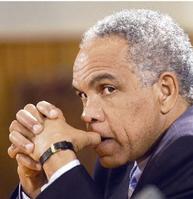Keith Collister, Contributor

Dr. Omar Davies, Minister of Finance and Planning will tell how he plans to finance the Budget on April 27. - FILE
LAST WEEK, the Government released its spending estimates for the new fiscal year 2006/2007. Estimated total expenditure, both recurrent and capital, for the current fiscal year of $358.1 billion (excluding appropriations in aid which would bring the budget to $360.5 billion) was nearly 3.5 per cent above last year's revised estimate of $346.3 billion. This was split between recurrent expenditure of $211.6 billion, and capital expenditure of $146.5 billion.
However, because capital expenditure includes amortisation of $117.6 billion to repay the principal coming due this year of both local ($101 billion) and foreign (US$16.6 billion) debt, it is highly misleading to use the overall expenditure figure to calculate the degree of fiscal restraint.
This can readily be observed when we compare last year's much higher figure for amortisation of nearly $140 billion (by itself nearly equal to the total for capital expenditure for the current fiscal year) out of a total capital expenditure of $157.2 billion according to the revised estimates, which are themselves approximately $3 billion below the original budget for capital expenditure of $160.2 billion for 2005/2006.
INCREASE IN RECURRENT EXPENDITURE
A better starting point is to look at the increase in total recurrent expenditure, which is programmed to rise by 11.6 per cent (above projected single digit inflation) or $22.1 billion in the new fiscal year above the revised expenditure estimate of $189.5 billion for fiscal year 2005/2006.
This revised estimate is of course an overrun of approximately $2.3 billion above the originally approved recurrent expenditure budget of $187.2, largely reflecting the additional 'MoU allowance' paid to the public sector unions to compensate them for the Government's failure to meet its single digit inflation target.
Last year's budget is significantly tighter than this year's, as Government had projected a fall in recurrent expenditure of nearly $2.6 billion below 2004/2005 actual expenditure of $189.8 billion.
While actual expenditure was approximately flat over 2004/2005, after inflation the budget performance was probably tighter in real terms.
BUDGETED RISE IN INTEREST COSTS
One key area of concern is that a critical element of the recurrent budget - interest costs - are projected to rise by 9.1 per cent or $7.7 billion to $92.4 billion in 2006/2007 from the revised expenditure estimate of $84.7 billion for 2005/2006. The latter estimate was below what was originally budgeted for interest costs for that fiscal year of $87.6 billion.
The increase in interest costs by itself accounts for almost a third of the budgeted increase in recurrent expenditure. This increase is the exact opposite of last year's situation when interest costs fell sharply from an extremely high $93.6 billion in the 2004/2005 fiscal year.
Clearly, the rise in interest costs will have made the budget harder to construct, and would be unsustainable if it were to become a long run trend.
While it is difficult to draw a final conclusion on the projected increase without deeper analysis of the numbers, it is likely that at least part of the rise in interest costs reflects the greater than anticipated increase in debt as a result of a higher than anticipated fiscal deficit, possibly three per cent of GDP, verses the originally projected balanced budget.
RISE IN NON-INTEREST EXPENDITURE
A better measure of the level of fiscal restraint is the increase in non-interest recurrent expenditure, basically wages and programmes. The increase of almost 13.7 per cent from $104.8 billion to $119.2, means that there has been a significant increase in the budget in both nominal and real terms.
However, most of the increase appears to reflect a combination of an increase in the wage bill, and a massive increase in the allocation to contingencies of $8.9 billion, defined as an allocation 'to meet any additional expenditure which may arise in the year.'
The final wage settlement with the unions is likely to be higher than projected in the current budget estimates, so that some (if not all ) of the contingency could be used up in further wage increases.
In summary, the increase in non-interest expenditure is likely to be driven primarily by wage growth, so that most of the budget increases for the big three ministries of security, health and education are likely to reflect wage as opposed to programme growth, with only a few smaller Ministries receiving sufficiently substantial percentage increases to increase programme spending e.g. tourism and agriculture, although this would partially reflect their increased portfolio responsibilities e.g. the addition of culture and land, respectively.
RISE IN CAPITAL EXPENDITURE
This year's allocation for capital expenditure (excluding debt repayment) was increased by $11.6 billion from the $17.3 billion budgeted in 2005/2006 to $28.9 billion, which when added to projected recurrent expenditure of $211.6 probably gives the truest measure of expenditure for 2006/2007 of $240.5 billion, or $36 billion above the equivalent budget for last year at $204.5 billion.
This emphasis on the future is possibly the most positive part of the current budget, although some may argue that it is further confirmation that we will have an election this year.
This larger than usual capital expenditure allocation may also act as an 'additional contingency' in the budget, with the Government able to cut expenditure in this area to meet targets.
While not recommended, this may give the government some additional leeway to compensate for the likelihood that its contingency budget may largely be swallowed up by wage increases, leaving very little to deal with weather-driven 'acts of god', or to compensate for non-central government losses such as those likely to be generated by Air Jamaica.

